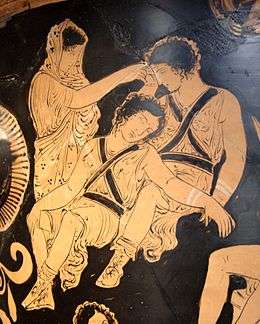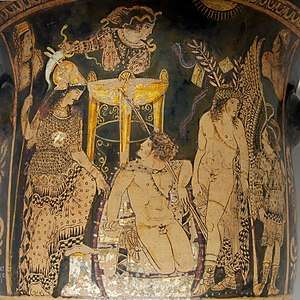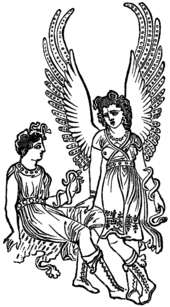Erinyes
The Erinyes (/ɪˈrɪniˌiːz/; sing. Erinys /ɪˈrɪnɪs/, /ɪˈraɪnɪs/;[1] Greek: Ἐρινύες, pl. of Ἐρινύς, Erinys),[2] also known as the Furies, were female chthonic deities of vengeance in ancient Greek religion and mythology. A formulaic oath in the Iliad invokes them as "the Erinyes, that under earth take vengeance on men, whosoever hath sworn a false oath".[3] Walter Burkert suggests they are "an embodiment of the act of self-cursing contained in the oath".[4] They correspond to the Dirae in Roman mythology.[5] The Roman writer Maurus Servius Honoratus wrote (ca. 600 AD) that they are called "Eumenides" in hell, "Furiae" on earth, and "Dirae" in heaven.[6][7]

| Greek deities series |
|---|
| Chthonic deities |
According to Hesiod's Theogony, when the Titan Cronus castrated his father, Uranus, and threw his genitalia into the sea, the Erinyes (along with the Giants and the Meliae) emerged from the drops of blood which fell on the earth (Gaia), while Aphrodite was born from the crests of sea foam.[8] According to variant accounts,[9] they emerged from an even more primordial level—from Nyx ("Night"), or from a union between air and mother earth.[10] Their number is usually left indeterminate. Virgil, probably working from an Alexandrian source, recognized three: Alecto or Alekto ("endless"), Megaera ("jealous rage"), and Tisiphone or Tilphousia ("vengeful destruction"), all of whom appear in the Aeneid. Dante Alighieri followed Virgil in depicting the same three-character triptych of Erinyes; in Canto IX of the Inferno they confront the poets at the gates of the city of Dis. Whilst the Erinyes were usually described as three maiden goddesses, the Erinys Telphousia was usually a by-name for the wrathful goddess Demeter, who was worshipped under the title of Erinys in the Arkadian town of Thelpousa.
Etymology
The word Erinyes is of uncertain etymology; connections with the verb ὀρίνειν orinein, "to raise, stir, excite", and the noun ἔρις eris, "strife" have been suggested; Beekes, pp. 458–459, has proposed a Pre-Greek origin. The word Erinys in the singular and as a theonym is first attested in Mycenaean Greek, written in Linear B, in the following forms: 𐀁𐀪𐀝, e-ri-nu, and 𐀁𐀪𐀝𐀸, e-ri-nu-we. These words are found on the KN Fp 1, KN V 52,[11] and KN Fh 390 tablets.[12]
Description
The Erinyes live in Erebus and are more ancient than any of the Olympian deities. Their task is to hear complaints brought by mortals against the insolence of the young to the aged, of children to parents, of hosts to guests, and of householders or city councils to suppliants—and to punish such crimes by hounding culprits relentlessly. The Erinyes are crones and, depending upon authors, described as having snakes for hair, dog's heads, coal black bodies, bat's wings, and blood-shot eyes. In their hands they carry brass-studded scourges, and their victims die in torment.[13]
Three sisters
According to some sources, the three classic Furies sprang forth from the spilled blood of Uranus when he was castrated by his son Cronus. The sisters are:
Cult
Pausanias describe a sanctuary in Athens dedicated to the Erinyes under the name Semnai:
Hard by [the Areopagos the murder court of Athens] is a sanctuary of the goddesses which the Athenians call the August, but Hesiod in the Theogony calls them Erinyes (Furies). It was Aeschylus who first represented them with snakes in their hair. But on the images neither of these nor of any of the under-world deities is there anything terrible. There are images of Pluto, Hermes, and Earth, by which sacrifice those who have received an acquittal on the Hill of Ares; sacrifices are also offered on other occasions by both citizens and aliens.[14]
In ancient Greek literature

Myth fragments dealing with the Erinyes are found among the earliest extant records of ancient Greek culture. The Erinyes are featured prominently in the myth of Orestes, which recurs frequently throughout many works of ancient Greek literature.
Aeschylus
Featured in ancient Greek literature, from poems to plays, the Erinyes form the Chorus and play a major role in the conclusion of Aeschylus's dramatic trilogy the Oresteia. In the first play, Agamemnon, King Agamemnon returns home from the Trojan War, where he is slain by his wife, Clytemnestra, who wants vengeance for her daughter Iphigenia, who was sacrificed by Agamemnon in order to obtain favorable winds to sail to Troy. In the second play, The Libation Bearers, their son Orestes has reached manhood and has been commanded by Apollo's oracle to avenge his father's murder at his mother's hand. Returning home and revealing himself to his sister Electra, Orestes pretends to be a messenger bringing the news of his own death to Clytemnestra. He then slays his mother and her lover Aegisthus. Although Orestes' actions were what Apollo had commanded him to do, Orestes has still committed matricide, a grave sacrilege.[15] Because of this, he is pursued and tormented by the terrible Erinyes, who demand yet further blood vengeance.[16]

In The Eumenides, Orestes is told by Apollo at Delphi that he should go to Athens to seek the aid of the goddess Athena. In Athens, Athena arranges for Orestes to be tried by a jury of Athenian citizens, with her presiding. The Erinyes appear as Orestes' accusers, while Apollo speaks in his defense. The trial becomes a debate about the necessity of blood vengeance, the honor that is due to a mother compared to that due to a father, and the respect that must be paid to ancient deities such as the Erinyes compared to the newer generation of Apollo and Athena. The jury vote is evenly split. Athena participates in the vote and chooses for acquittal. Athena declares Orestes acquitted because of the rules she established for the trial.[17] Despite the verdict, the Erinyes threaten to torment all inhabitants of Athens and to poison the surrounding countryside. Athena, however, offers the ancient goddesses a new role, as protectors of justice, rather than vengeance, and of the city. She persuades them to break the cycle of blood for blood (except in the case of war, which is fought for glory, not vengeance). While promising that the goddesses will receive due honor from the Athenians and Athena, she also reminds them that she possesses the key to the storehouse where Zeus keeps the thunderbolts that defeated the other older deities. This mixture of bribes and veiled threats satisfies the Erinyes, who are then led by Athena in a procession to their new abode. In the play, the "Furies" are thereafter addressed as "Semnai" (Venerable Ones), as they will now be honored by the citizens of Athens and ensure the city's prosperity.[18]
Euripides
In Euripides' Orestes the Erinyes are for the first time "equated" with the Eumenides[19] (Εὐμενίδες, pl. of Εὐμενίς; literally "the gracious ones", but also translated as "Kindly Ones").[20] This is because it was considered unwise to mention them by name (for fear of attracting their attention), the ironic name is similar to how Hades, god of the dead is styled Pluton, or Pluto, "the Rich One".[13] Using euphemisms for the names of deities serves many religious purposes.
Sophocles
In Sophocles's play, Oedipus at Colonus, it is significant that Oedipus comes to his final resting place in the grove dedicated to the Erinyes. It shows that he has paid his penance for his blood crime, as well as come to integrate the balancing powers to his early over-reliance upon Apollo, the god of the individual, the sun, and reason. He is asked to make an offering to the Erinyes and complies, having made his peace.
Modern references and literature
_-_Google_Art_Project.jpg)
The Erinyes persist as a theme that appears in modern literature. They are mentioned in the poem "To Brooklyn Bridge" by Hart Crane. The Eumenides are also featured in T. S. Eliot's play, The Family Reunion, Neil Gaiman's comic book series, The Sandman, and Rick Riordan's book series, Percy Jackson and the Olympians. In the 1875 comic opera Trial by Jury by W.S. Gilbert and Arthur Sullivan, the Learned Judge describes himself as having once "danced a dance like a semi-despondent fury" while in Westminster Hall. The movie franchise Alien is said to be inspired by the Erinyes.[21] The Kindly Ones (original French title Les Bienveillantes), a 2006 Holocaust novel by Johnathan Littell, draws not only its title, but also many of its themes and its structure from Aeschylus's Oresteia trilogy.
Notes
- "Erinyes". Dictionary.com Unabridged. Random House. Retrieved 12 September 2013.
- Lidell and Scott, s.v. Ἐρινύς
- Homer, Iliad 19.259–260; see also Iliad 3.278–279.
- Burkert, p. 198
- Chisholm, Hugh, ed. (1911). . Encyclopædia Britannica (11th ed.). Cambridge University Press.
- Servius, Commentary on Virgil's Aeneid 4. 609
- John Lemprière (1832). Lemprière's Classical Dictionary for Schools and Academies: Containing Every Name That Is Either Important or Useful in the Original Work, p. 150.
- Hesiod, Theogony 173–206.
- Aeschylus Eumenides 321; Lycophron 432; Virgil Aeneid 6.250; Ovid Metamorphoses 4.453.
- Graves, pp. 33–34.
- Chadwick, p. 98: "Then comes a surprising figure: Erinus, the later name, usually in the plural, for the Furies or avenging spirits believed to pursue murderers. The same name has now been deciphered on the edge of the famous list of Greek gods at Knossos (V 52) with which I began this chapter."
- Chadwick, p. 98: "Here we have another reference to Erinus (Fh 390)..."
- Graves, pp. 122–123.
- Pausanias, 1.28.6 (trans. Jones)
- Trousdell, Richard (2008). "Tragedy and Transformation: The Oresteia of Aeschylus". Jung Journal. 2 (3): 5–38. doi:10.1525/jung.2008.2.3.5. JSTOR 10.1525/jung.2008.2.3.5.
- Henrichs, Albert (1994). "Anonymity and Polarity: Unknown Gods and Nameless Altars at the Areopagos". Illinois Classical Studies. 19: 27–58. JSTOR 23065418.
- Hester, D. A. (1981). "The Casting Vote". The American Journal of Philology. 102 (3): 265–274. JSTOR 294130.
- Mace, Sarah (2004). "Why the Oresteia's Sleeping Dead Won't Lie, Part II: "Choephoroi" and "Eumenides"". The Classical Journal. 100 (1): 39–60. JSTOR 4133005.
- Gantz, p. 832.
- Suid. s.v. Ἄλλα δ' ἀλλαχοῦ καλά
- Hoad, Phil (30 August 2019). "Memory: The Origins of Alien review – inside the secret psyche of a monster". The Guardian. ISSN 0261-3077. Retrieved 1 October 2019.
References
- Aeschylus, "Oresteia". Trans. Lloyd-Jones. Lines 788–1047.
- Beekes, Robert S. P. (2009), Etymological Dictionary of Greek, Leiden: E.J. Brill.
- Burkert, Walter, 1977 (tr. 1985). Greek Religion (Harvard University Press).
- Chadwick, John (1976). The Mycenaean World. Cambridge, England: Cambridge University Press. ISBN 978-0-521-29037-1.
- Gantz, Timothy, Early Greek Myth: A Guide to Literary and Artistic Sources, Johns Hopkins University Press, 1996, Two volumes: ISBN 978-0-8018-5360-9 (Vol. 1), ISBN 978-0-8018-5362-3 (Vol. 2).
- Graves, Robert; The Greek Myths, Moyer Bell Ltd; Unabridged edition (December 1988), ISBN 0-918825-80-6.
- Hesiod, Theogony. trans. Hugh G. Evelyn-White. 1914. Lines 176–206. Online Text: Perseus Project. Tufts University.
- Homer, The Iliad with an English Translation by A. T. Murray, PhD in Two Volumes. Cambridge, Mass., Harvard University Press; London, William Heinemann, Ltd. 1924. Online version at the Perseus Digital Library.
- Liddell, Henry George, Robert Scott. A Greek-English Lexicon. Revised and augmented throughout by Sir Henry Stuart Jones with the assistance of. Roderick McKenzie. Oxford. Clarendon Press. 1940. Online version at the Perseus Digital Library
- Littleton, Scott. Gods, Goddesses, and Mythology, Volume 4. Marshall Cavendish Corporation, 2005. Google Book Search. Web. 24 October 2011.
- Pausanias, Pausanias Description of Greece with an English Translation by W.H.S. Jones, Litt.D., and H.A. Ormerod, M.A., in 4 Volumes. Cambridge, MA, Harvard University Press; London, William Heinemann Ltd. 1918. Online version at the Perseus Digital Library.
- Scull, S. A. Greek Mythology Systematized. Philadelphia: Porter & Coates, 1880. Print.
- Virgil, Aeneid vii, 324, 341, 415, 476.
- Wilk, Stephen R. Medusa: Solving the Mystery of the Gorgon. Oxford: Oxford University Press, 2000. Google Book Search. Web. 24 October 2011.